Review and analysis of Achaemenid works in Egypt
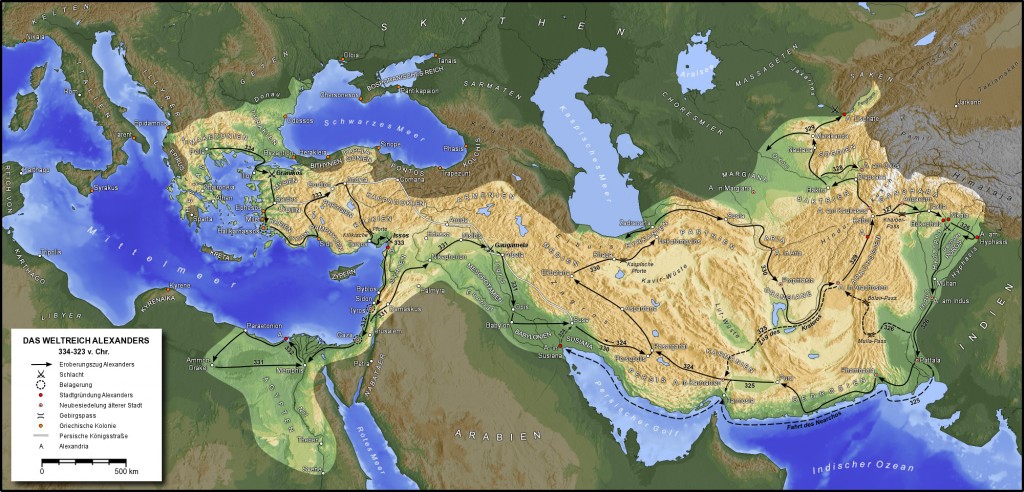
Taken from the wisdom forum of the author Fariba Saghri
Table of Contents
۱) Foreword
۲) Digging the Suez Canal by Dariush Kabir
۳) Persian inscriptions in the Egyptian Museum
۴) The relief of the mourning ceremony of one of the Achaemenians in Egypt obtained from Memphis
۵) The remains of 2,500-year-old bodies of Iranian soldiers in the Egyptian desert
۶) Temple of Hibis
۷) Odjahorsent statue
۸) Stamped and cylinder seals from the Achaemenid period in Egypt
۹) Papyri from Elephantine
۱۰) References
Foreword
If until several decades ago, the knowledge of the Achaemenid period in Egypt was mainly based on the data of classical texts, today the archaeological works of Gonakon are the most important sources for investigating the cultural, political and economic structures of Egypt during the two Achaemenid dynasties. However, the archaeological research of the Achaemenid conquest period In Egypt, due to the neglect of researchers to this period and as a result the lack of data and findings compared to the vast amount of information related to other historical periods of Egypt, the oldest available reports of archaeological excavations in the sites of this period are insignificant. Egypt is very fragmented and inadequate, and new excavations in such sites are evolving. Most of the works obtained from old excavations (Such as stone vessels, figures, jewelry and charms and things like that) They lack precise archaeological context and are generally kept in different museums of the world and outside of Egypt. In addition to these, the weather conditions and the concentration of modern residential constructions on most of the ancient sites of the Delta, which are the most important urban centers of late Egypt. 664 BC to Alexander's attack, among other problems that limit the access to the sites and data of this period. The presence of Achaemenians in Egypt dates back to the time of Kamboja, the son of Cyrus. In the campaign to Egypt, he was able to face Pharaoh Pasmetich III (Psalm 3) He won from the 26th dynasty of Egyptian pharaohs and turned that country into one of the satrapies or Achaemenid states.. After Cambogia, Darius I also ruled Egypt. The first period of Achaemenid rule over Egypt lasted about seventy-seven years. It is natural that the presence of the Achaemenids in Egypt caused the influence of Egyptian and Achaemenid art, architecture and engineering on each other, of which brief signs are now left..
a thousand) Digging the Suez Canal by Dariush Kabir
From the Achaemenid rule over Egypt, numerous works and monuments have been left, most of which are from the time of Darius I.. One of the most important works left from the time of Darius in Egypt is the waterway that connects the Nile to the Red Sea.. Along the route of this waterway, five memorial stone pillars of this king have been identified so far. Construction of a waterway to the Red Sea (red) It has a long history to connect it to the Nile River and the Mediterranean Sea. Pharaohs of Egypt at least since the second millennium BC (And maybe from the third millennium) They have been thinking of building such a waterway and during the time of Pharaoh Nakhao/Nakho (609 to 594 BC) The construction of the waterway had progressed to a great extent. Abu Rihan al-Biruni mentions the first pharaoh who ordered the construction of an aqueduct named "Sastratis" in "Determining the Limits of the Places"; While Herodotus (The second book, paragraphs 158 and 159) Nakhao is regarded as the initiator of the construction of the waterway. Herodotus also mentions that Darius finished the construction of the waterway; Emma Biruni and Diodorus Siculus (Book I, paragraph 33) It is said that Darius refused to continue the work due to the fear that the difference in the sea level would cause flooding in Egypt and left the waterway half finished.. These two historians have unanimously reported that the construction of the aqueduct during the time of Ptolemy II / Philadelphus (285 to 246 BC) The second king of Batalse dynasty (The Ptolemies) Finished. However, Herodotus' report is in accordance with Darius' inscription and tells about the completion of the construction of the waterway and the running of ships during the time of this king.. Strabo's opinion about this is in accordance with the external. He reports that the digging of this waterway was first started by "Sostris" before the Trojan wars and Darius followed it.. But for the same reason, he refused to continue the work (Book 17, paragraph 25). The name of the king that Strabo narrates is very similar to that given by Biruni. As seen on the map, part of the route of this ancient waterway is the current route of the Suez Canal (In Arabic "Qana Al Suwais") which was completed in 1869, is different. The current Suez Canal from the city of Suez in the north of the gulf of the same name at the end of the dead end of the Red Sea (Qulzm Sea) It is true, it begins and after passing through bitter lakes and crocodiles to the port of Port Said by the Mediterranean Sea. (Maghreb Sea) arrives. But the route of the ancient waterway matches the current route of the canal only up to the crocodile lake, and it turns west from this lake to the city of Zagazig. (Bobastis) It is located next to a tributary of the Nile River. The difference between ancient and modern waterways lies in the goals of their builders. The purpose of building this waterway in ancient times- Contrary to the intention of the builders of today's Suez Canal- It was not only the connection of the Mediterranean Sea with the Red Sea and the connection of the open waters of the eastern and western lands. Rather, the main goal has been to connect the large and numerous cities and villages of Egypt and the banks of the Nile River with the eastern lands and create a commercial waterway.. It is for this reason that the waterway connects the Red Sea and the Nile River. The waterway, which was created during the time of Pharaohs and Darius to connect the Red Sea to the Nile and the Mediterranean Sea, has four natural sections and three artificial sections.. The natural parts of the waterway are:: ۱- Great Bitter Lake, 2- Crocodile Lake, 3- A tributary of the Nile, 4- the Nile. The artificial and excavated parts of the waterway are:: ۱- The distance between the city of Suez and bitter lake, 2- The distance between bitter lake and crocodile lake, 3- The distance between the crocodile lake and the branch of the Nile, which passes through Tumilat valley and reaches the side of Zagazig city.. From here on, the ships have gone to the Nile River through the Nile tributary, and then they have departed on the Nile to various cities or entered the Mediterranean Sea.. There is also a theory that bitter lakes and alligators were not part of the route and the waterway passed by these lakes.. Strabo has a different opinion about this. He narrates that because the bitter lake was a part of the waterway, the fresh water of the Nile has removed its bitterness and fishes and birds have gone there. (Book 17, paragraph 25). Now a part of this ancient waterway is used in the construction of the Ismailia water supply channel.
Dariush, five inscriptions on a red granite stone (Sumac stone) There is an inscription next to this important waterway, which is a reminder of this great and wonderful engineering and surveying program in ancient times.. The stones have a height of about 3 meters and are not native to their location; Rather, they were procured from another place and installed in their current location after the completion of stonework. Apparently, all five versions are copies of each other and have no difference in content. The first inscription is located at the beginning of the waterway near the current city of Suez. The second inscription is in the city of Shalouf/al-Shalofah, which is located in the middle of a field in this city today. The third inscription was erected at the beginning of the bitter lake and in the place of the current city of Kebrit. The fourth inscription is located near the city of Sarabeum/Sarabeum and the fifth inscription is located near Tell Maskhuta/Tal al-Maskhuta.. None of these five inscriptions have remained intact, and the knowledge of their content and themes is possible by comparing with each other and correcting the destroyed parts of each with intact parts in another version.. The first inscription was identified by Charles du Lesseps in 1866 during the construction of the Suez Canal, and other copies were found until 1913.. Dariush's memorial stones, apart from his inscription and decree, also contain drawings and paintings.. The person of Darius on one side of the memorial stone in Iranian clothes and in front of the Iranian god (Mazda) And on the other side, in the clothes of Egyptian pharaohs and before the Egyptian God (Khudabanu "Not/Net") can be seen. On either side of the memorial stones, the symbol of the sun/winged orb above his head and the gods is waved.. In the Egyptian part of the inscription and below the figures of Darius and Not, there are images of the representatives of the lands under his rule while kneeling on the ground, along with the names of their respective lands in Egyptian script and language.. Similar to these pictures can be seen on the base of the stone statue of Darius, which was made in Egypt and found in Susa.. Darius memorial stone inscriptions on the side of this waterway are known by the general name Darius Inscription in Suez and with the symbol DZ.. Each stone has two sides, on one side there are inscriptions in ancient Persian, Elamite, Akkadian and cuneiform languages. (New Babylonian) And on the other side, an inscription is written in hieroglyphs and Egyptian language. The Akkadian texts that were in the lowest part of the stones are almost completely lost and the Elamite texts are also very damaged.. In the Egyptian hieroglyphic text, parts of which have remained intact, there are themes and interpretations that cannot be seen in the ancient Persian text.. The best surviving hieroglyphic text among the inscriptions of Darius is the version located near Tell Meskhuta..
In this text, Dariush's name is written in its Egyptian sound, "Triosh", in an oval frame between his image and the image of the goddess "Not".. He calls himself and the sun god the sons of Nut and remembers that with the help and support of Nut and the bow that he offered, he was able to defeat all his enemies and that everyone brought him tribute and served him.. He also mentions his lineage and adds that Nott has reached out to help him.. In the continuation of the hieroglyphic text, there are a number of names of the former kings of Egypt and Iran, including the name of Cyrus, which, of course, have largely disappeared..
But the most sound ancient Persian text among the various copies of this inscription belongs to Shalouf and Kebrit versions.. Stone inscription of Darius in the Suez waterway, match copy, ancient Persian and Elamite text, design from the same source, quoted by Manan J. Ménanat, the first part of this text, has one line and one word, which is the name of Darius alone. This name is like hieroglyphic text in an oval frame between his image and God's image (Here is Ahura Mazda) Written. The second part has seven lines in ancient Persian on the right side of the figures and behind the head of Darius, as well as four lines in Elamite and three lines in Akkadian written on the left side of the figures and behind the head of Ahura Mazda.. The third part, which contains the main text of the order for the construction of aqueducts, has twelve lines in ancient Persian and the remaining seven lines in Elamite, where the continuation of the Elamite text along with the entire Akkadian text has been lost.. On the other side of this stone, like the version of Tell Meskhuta, there is a damaged hieroglyphic text. The first transliteration and translations from the ancient Persian text were made by Kaytan Andreevich Kasovich C. Kossowicz in 1872 in St. Petersburg, Tolman H. C. Tolman in 1908, Weisbach F. H. Weissbach in 1911 and Kenneth R. G. Kent published in French, English and German in 1942. These transliterations and translations have become more accurate and complete until the time of Ronald Kent. This writer's translation is especially based on Kasovich's reading of the original text and the suggestions of Walter Hintz W. Hinz for the pronunciation of ancient Persian words and revision of his previous translation in the book of Achaemenid inscriptions. (Fourth edition, 2008) Based. Persian translation of the ancient Persian inscription of Darius the Great in Suez: The first part (DZa), Clause 1: Dariush [Ancient Persian: Darius]. Part II (DZb)Paragraph 1, lines 1 to 7: The great king, the king of kings, the king of the lands, the king in this great land, the son of Vishtasep [Wistaspe]Achaemenid [Achaemenianism]. third part (DZc), paragraph 1, lines 1 to 4: The great god is Ahuramazda [Ahuramazdah], to create that sky. To create this earth, to create man, to create happiness for man, who gave Darius a king, who gave Darius a great governor, with good horses, with good people. The third part, paragraph 2, lines 4 to 7: I am Darius, the great king, the king of kings, the king of lands with diverse peoples, the king of this great, wide and far-reaching land, the son of Vishtasep, Achaemenid. The third part, paragraph 3, lines 7 to 12: Dariush Shah says, I am Persian, from Pars [Parse] Egypt [currency] took, I ordered to dig this waterway [Yoya], from a river named Nile [follow] which flows in Egypt, towards the sea that goes from Persia, so then this waterway was cut, as was my order, and the ships [Naoya] In this waterway, they went from Egypt to Persia, as I wanted. Darius' introduction in this inscription has differences from his other inscriptions. For example, here the creation of the sky came before the creation of the earth, or the famous phrase "one king of many, one ruler of many" was avoided.. In the Suez inscription, Darius specified the beginning and the end of the waterway, which is the Nile and the Red Sea, by quoting the phrase "from a river called the Nile that flows in Egypt, to the sea that goes from Persia.". Here, the reader expects that instead of "to the sea that goes from Pars", the sentence "to the sea that goes to Pars" is written.. But it seems that this text was dictated while Darius was in Pars (Iran) and instead of the word "Abiyi", he used the word "Hacha". As a result, the text of the inscription is written in one place from the perspective of a speaker living in Egypt and in another place from the perspective of a speaker living in Iran.. Another point in Dariush's inscription is his reference to "capturing" Egypt; While we know that Egypt was captured during the time of Kamboja/Kamboja II. This is neither a mistake nor the attribution of the achievements of the predecessors to one's own benefit. Rather, this statement of Darius refers to the recapture of Egypt after the suspicious death of Kamboja and his battle with the Iranian ruler of Egypt.
B) Persian inscriptions in the Egyptian Museum
The collection of hieroglyphic inscriptions found in Hammamat Valley attributed to Ethiavahi, which was written during the reign of Darius I - Xerxes I - and Ardashir I, in the years 476-473 BC. It is an authentic document of interaction and understanding between Iran and Egypt. In these documents, "Xerxes" is addressed as "lord of two countries". [King of two countries, son of Ra (Egyptian God) May the owner of the dead live forever]. This is the same phrase that appears on some stone vases found in Persepolis and Susa. On the first floor of the museum, a large map from 1906 is installed in the place of the corridor stairs to the second floor of the museum, where there is the Persian Gulf.. In the Library of Alexandria, there is a unique color map attached to a book from 200 years ago, which has drawn the map of the Persian Gulf with its original name and with saffron ink.. This book and its map have been registered as UNESCO World Heritage Sites. "Ali Sami" writes in his book "Achaemenid Civilization" that a total of 117 Iranian and Achaemenid works are written in Egyptian script. (Hieroglyph) And "Demotique", the ancient Egyptians' judicial and administrative script, has been discovered so far on stones, tablets, seals, and metal vessels, most of which date back to the time of Darius I and King Xerxes..
c) The relief of the mourning ceremony of one of the Achaemenians in Egypt obtained from Memphis
The opposite photo shows a 45 cm long stone on which the mourning ceremony of one of the Iranian rank-and-file officers during the Achaemenid period in Egypt is engraved.. This relief was found in Memphis, Egypt. Mourners include these people: Scythian servants wearing trousers, a man with a horse, women/female servants bare-breasted and doing their hair (These two are considered signs of mourning in Egypt) And also two angel-like beings. The devices that can be seen in this relief have Iranian style and form.
of the) The remains of 2,500-year-old bodies of Iranian soldiers in the Egyptian desert
According to the MSNBC site, in a discovery, next to the remains of the bodies of strong soldiers, a large amount of military equipment, including bronze weapons, silver bracelets, earrings, along with hundreds of bones, was found in a huge desert area. It was discovered in the remote desert region of western Egypt that, based on historical references, are the remains of Iranian soldiers of Cambyses II, the Achaemenid king of ancient Iran - whose name was changed by the Arabs to Cambodia.. These soldiers were buried alive under the sand layers of the desert in 525 BC due to being caught in a sand storm.. After seven days of marching in the desert, these soldiers reach an area that is now known as Al-Kharqa, and it was then that the Iranian soldiers disappeared and no one found a trace of them. Herodotus in his history mentions strong winds that coincided with the presence The Iranians started blowing from the south and the resulting huge tornadoes and sandstorms engulfed the Iranian soldiers..
The archeology film that was shown at the "Roverto" festival represents three years of research and also five years of sending the archeology team to this area.. They started this activity in 1996 when they found iron tools near Siva and while they were working on the area, they found human corpses and bones in a pit, which they considered to be a natural shelter. they got; They found a reef 114.8 feet long, 5.9 feet wide, and 9.8 feet deep. Many of these natural shelters are found in the desert, but this one was the only shelter in that area and its size is suitable for sheltering and being safe from sandstorms; But the metal detectors of an Egyptian archaeologist found some bronze daggers and several bows. Although they found few tools, these tools were very important, because they were the first tools of the Achaemenians and their age goes back to the time of Cambyses, which were found under the sands in an area near Siwa..
e) Temple of Hibis
The reign of Darius I is the most important and the most important historical period of the Achaemenids because the Achaemenid Empire expanded the most during this period and important administrative and judicial reforms were carried out in this period.. During this period, the scope of the empire expanded from north and south, east and west. Dariush was also involved in political crisis and instability in this Iranian satrap in Egypt. In order to consolidate his rule, Darius in Egypt restored the administrative and governmental system to the previous state in the era of the pharaohs and also confirmed the old rights and benefits of the holy places and spiritual communities.. According to the Biston inscription, when Darius was in Babylon, Egypt, like other satraps, rebelled and was almost out of political power, when Darius conquered Egypt again without any major incident in 518 BC. The situation became dominant. Darius continued Cambogia's efforts to gain control over the important settlements in western Egypt and was able to build a large temple in Al-Kharqa Oasis.. By building the Hibis Temple in Al-Kharqa Oasis, Darius displayed reliefs with various scenes, including performing traditional Egyptian rituals and being fed by Egyptian gods. . It can be said about the geographical location of Al-Kharqa Oasis: Al-Kharqa Oasis is located in the western desert of Egypt. Probably Darius I, while traveling to the Al-Kharqa Oasis area, ordered the construction of religious buildings, including the great temple of Hibis, which is located 220 km southwest of Aswan and 210 km from Luxor. has it. The building of the Hibis Temple, which was built on the site of the tomb of the oldest and smallest Amen, is known as the Hibis Temple today. The construction of this temple took almost twenty years from 510 to 490 BC during the reign of Darius I. What is mentioned in the Egyptian texts regarding the construction of the Hibis Temple is that this temple was built by Darius I of Achaemenid and its walls were painted during the time of Darius II of Achaemenid.. This temple is 44 meters long, 19 meters wide and 8.5 meters high, and the overall space of the temple is arranged and shaped similar to Egyptian temples.. On the back of the bronze heel of the temple door there is an inscription in cuneiform with the words “Dariush Shah Shahan” It is probably related to Darius II who rebuilt and completed the temple in 424 BC..
Architectural features of Hibis temple :
۱- A pillared hall with twelve columns with palm and flower-shaped capitals and walls decorated with reliefs and inscriptions.- A sacrificial hall with walls covered in reliefs and religious texts depicting the king offering jars of wine to various gods in Egyptian temples.
۳- A pillared entrance hall of the temple or four pillars that define the forbidden area of the temple from the north and south with two warehouses, followed by the crypt and the place where the dead are kept and the place of reverence for Osiris, and a staircase leads to the roof.. There are three doors in the northern wall of the temple. One opens to the pillared hall and one to the altar hall and the third to the mihrab or the place where the valuables of the temple are kept.
۴) The side of the temple altar on the west side of the temple in the long position of the altar wall is decorated with various reliefs. These reliefs are the most important and our information about ancient Egyptian mythology. They show all the gods of Egypt, who in this period at their highest level displayed this theme in different forms..
Ms. Karl Misulevich, an archaeologist and author of the book "Dariush Hakim of the two countries of Iran and Egypt" believes: Darius built a number of temples to honor the Egyptian gods. including the Hibis temple in Al-Kharqa oasis, which was far from the religious centers of Egypt at that time. Ms. Karl Misolevich, an archaeologist and author of the book "Darius the Ruler of the Two Countries of Iran and Egypt" believes: Darius built a number of temples to honor the Egyptian gods. including the temple of Hibis in Al-Kharqa oasis, which was far from the religious centers of Egypt at that time.
The work of Darius' luggage in the temple of Hibis:
Tasheh work is the oval carvings of Egyptian pharaohs, which are written along with images and hieroglyphic texts for a purpose, or carved into the body of a wall or a statue, and this is the old tradition of pharaohs in promoting and presenting their own ideas.. The work of Darius' luggage in the temple of Hibis was painted in some cases, which were sometimes red or pale blue. .
Images of Darius I on the walls of the Hibis temple:
On the walls of the Hibis temple, there are carvings of Darius I, the Achaemenid king, in several places in the form of Egyptian pharaohs and in the style of Egyptian carvings.. Perhaps the reason for using this particular style in presenting the strange and unusual face of Dariush is that the artists did not have enough time to present better and more realistic images. Also, Dariush did not stay in Egypt for a long time and spent most of his time in Iran.. Another reason for this is that the Egyptians used to carve and sculpt their kings and pharaohs in the form of unique figures of gods before this period.. On the walls of the altar of the temple, there are various decorative reliefs, based on our knowledge of Egyptian mythology, all of them represent Egyptian gods.. On the outer walls of the temple, the reliefs of Darius I, the Achaemenid, can be seen bringing a sacrifice to the temple with special ceremonies in front of the gods, especially on the western side of the building of the Hibis temple, the entrance walls show images of Darius in the form of Egyptian pharaohs.. The Hibis temple in Al-Kharqa oasis, which is dedicated to Amun, and in this temple there are Egyptian mythological gods from centuries ago with scenes that created the worship of gods as royal propaganda, and in all these scenes, Darius the Achaemenid king as pharaoh. together with the Egyptian gods have shown.
Description of the scene of the reliefs of Darius in the temple of Hibis:
۱) In the first scene of the images of Darius I in the temple of Hibis, it is shown as a symbol of the two countries of Iran and Egypt as the ruler of the two countries, where Darius is sitting on a throne and the gods of Harzes Horus are next to him.. Horus with an eagle-shaped head and another god with a stork's head as Tut, the god of wisdom and knowledge in Egyptian mythology, both resting their feet on the base of the king's throne..
۲) In another scene, a god in the form of a winged eagle kills a huge snake with a spear. King Darius, one crown, two emblems (The sign of Upper Egypt and Lower Egypt) On his head and wings from the back of an eagle (Hawk) Has not shown. In addition, two images of an eagle with spread wings, with a sun disk on its head, behind the body of God (Dariush) and Shiri helps Dariush in this fight. It can be said that the Egyptian artist wanted to show the power and authority of Darius with this image.
۳) In another scene, for example, the king (Dariush) It shows entering the temple. In another scene, the goddess of courage and courage breastfeeds the young Darius, and in contrast to this scene, in another scene, the goddess of Amon embraces the adult king with long arms..
And) Odjahorsent statue
The most important archaeological document of this period of Egypt's history in relation to its conquest by Cambodia is the inscriptions of the Ojahorcent statue, which is now kept in the Vatican Museum.. He was a doctor at the court of Selezas and a high-ranking officer and commander of the Egyptian navy before the conquest of Egypt by Cambodia. . The statue of Ojahorsent shows a standing figure wearing a long robe and carrying in his hands a boat containing the face of Osiris. It is 70 cm tall and made of dark green stone.. The head, neck and left hand of the statue have been clumsily repaired and restored later. The inscription on the statue has a total of 48 columns and its contents are written independently of each other, the last of which is related to the reformation of the Syzes school by the order of Darius I, whose approximate date was the third year of Darius I's rule in Egypt..
Greek sources, including Herodotus and Strabo, claim that Cambogia set fire to Egyptian temples and mocked the Egyptian gods while harming them, and that Apis killed the sacred cow of the Egyptians and embalmed the body of Amasis, Pharaoh's father. He burned the captured Egyptian. The image of Cambogia in the book of Herodotus is the image of a cold-hearted foreign invader who is not interested in the social and religious beliefs of Egyptians.. But the Egyptian texts of that time do not confirm this image. The most important of these texts is the hieroglyph inscription carved on the statue of Ojahorsent. The incident of Cambodia's attack on Egypt is reported in this text : Cambogia, the great king of all foreign lands, came to Egypt and he conquered all the land of Egypt. He became the great ruler of Egypt and entrusted me with the position of head of doctors. He called me by his side”Friend” And “Palace Manager” He agreed and I gave him the royal title of King of Upper and Lower Egypt. I made the king recognize the importance and greatness of Sait Temple. This is the seat of the great intention of the mother who gave birth to Ra, who began to give birth when there was no birth. Cambodia's policy in Egypt was exactly the same as Cyrus' policy in Babylon. It means consolidating ties with the local elite, accepting himself as a good ruler and playing the role of the king of Egypt, in the proper way that was expected from Cambodia.. It means to honor the gods and give gifts and offerings, protect the temples and accept Egyptian ceremonial titles and names..
Z) Stamped and cylinder seals from the Achaemenid period in Egypt
One of the most important works of the reign of the Persians in Egypt are the royal seals, which were common in most of the satraps and countries under the Achaemenid Empire. This seal of the great king was common. In fact, not only such unique seals existed, but more than 30 seals were available. Is. If during the time of Dariush, all the high-ranking officials, including all the governors who were considered among the high-ranking officials, had such a seal with the name of Dariush.. An example of the seal of the era of Persian rule in Egypt from the seal of Darius, which was only a unique example. Darius I probably granted it to newly appointed governors in Egypt in 487 BC.. The second example of the seals of the era of the Persians in Egypt is in the form of a rolling or cylindrical and hollow seal.. An image of an Achaemenid king standing with a spear in his hand is carved on the surface of the seal.. The Pharaoh of Egypt is also kneeling in front of him.
h) Papyri from Elephantine
Thanks to its easy alphabet, the Aramaic script, from the 8th century BC in the region of Egypt, Palestine and parts of Asia Minor, became more and more the language of communication. “international” and finally became an independent form “Ancient Aramaic” It became the official administrative language of the Achaemenids. Many documents have reached us about this language, which scientists call imperial or official Aramaic, including the documents of the military settlement of the Elephantine Jews. (An island in the Nile opposite Aswan) in the south of Egypt, who acted on behalf of the kings of Iran, as well as letters written on leather by Arsham (Armasses) Achaemenid prince and satrap of Egypt, pointed out . In the years 1907-1906, from the archaeological excavation conducted by Robinson in the Elephantine Island, the result was the discovery of an important archive and archive of the Jewish military immigrants of the Elephantine Island in Aramaic script and on papyrus. It was preserved there, it was found in the Jewish Military Complex of Elphantine Nile. These documents were written on both sides of the papyrus, and the administrative notes of the Achaemenid period were written in their margins.. Papyrus writings in Aramaic provide a vivid picture of life in settlements such as the Jewish garrison at Elephantine, attesting to the worship of Yahweh and the temples of the local deities, as well as their relationships with other groups who lived there. Even these Aramaic papyrus writings have successfully attempted to provide the geographical location of the Elephantine neighborhoods for reconstruction or visualization with explanations.. The Aramaic papyri from Elephantine provide an almost unique source of information about the administration of courts and justice, as well as the state of the courts and their governing principles and procedures.. Because the documents of the Egyptian courts during the Saite era and during the Achaemenid rule have not been found so far, and there is no information about this..
references:
۱ – Sami, Ali, Achaemenid Civilization, first volume, Samt Publications, second edition, 1389
۲ – Sansisi, Helen, Kurt, Amelie, Achaemenid history (Asia Minor and Egypt, ancient cultures in a new empire)The sixth volume, translation: Morteza Saqib Far, Tos Publications, first edition 2008
۳ – Khodadadian, Ardeshir, History of Ancient Egypt, Tehran University Publications, 2013
۴ – Kalikan, William, Archeology and History of Art in the Age of the Medes and Persians, translated by Gouders Asaad Bakhtiari, Pazineh Publications, second edition, 2005
۵ – Kurt, Amelie, Achaemenians, translated by Morteza Saqib Far, Ghoqnos Publishing House, 6th edition, 2009
۶ – Qaim Maggi, Jahangir, Achaemenid inscriptions in the Nile River, Historical Studies Magazine, special issue for the 2,500 year celebrations, 6th year, Mehr 1350
۷ – Marie Koch, Hyde, from the language of Dariush, translated by Parviz Rajabi, published by Karang, 13th edition, 2006
۸ – Mohammad Panah, Behnam, Secrets of Ancient Egyptian Civilization, Sabzan Publication, 2005
۹ – Velayati, Rahim, Studying the influence of Egyptian art in the Achaemenid period, Journal of Faculty of Literature and Humanities, 2015
۱۰ – Velayati, Rahim, review and introduction of Achaemenid architectural works in Egypt, Safa Magazine, Cultural Heritage Publications
۱۱ – Velayati, Rahim, Hibis Temple, a monument of Achaemenian architecture in Egypt, Journal of Art, No. 36 and 37, 2003
۱۲ – Velayati, Rahim, A study of part of the archaeological findings related to the art of the Achaemenid period in Egypt, Bagh Nazar Magazine, No. 10, Fall and Winter 2007
۱۳- Journal of Archeology No. 12-13, publication date 2011
Text taken from the site ((wisdom community)) Written by Mrs. Fariba Sagri
See :
Review and analysis of Achaemenid works in Egypt
This text is in line with The new policy of Parsian Dej It is located on this site.



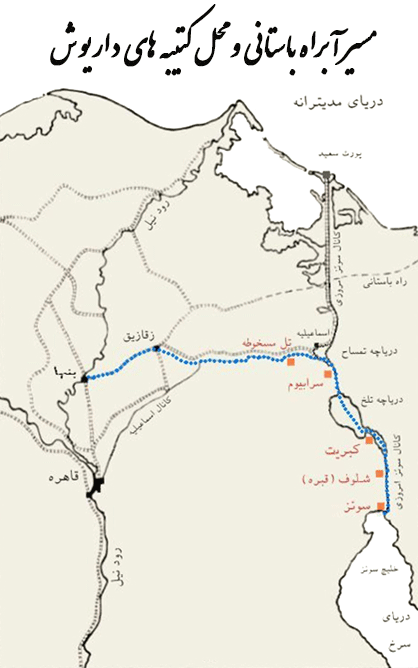
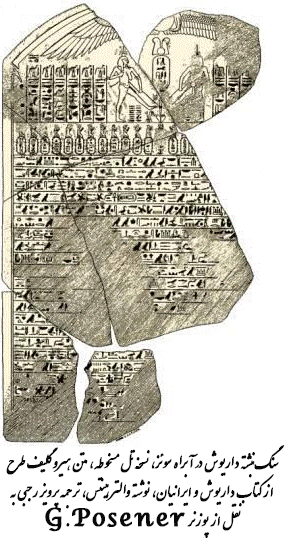

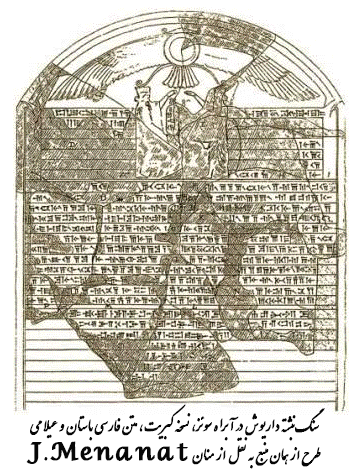
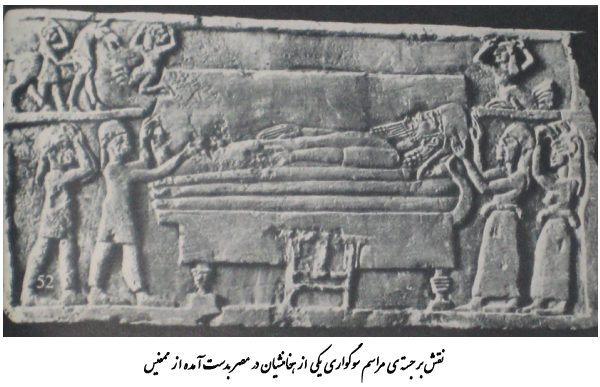
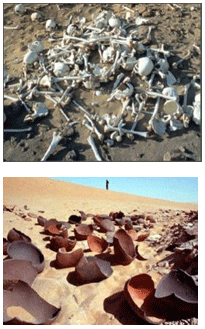
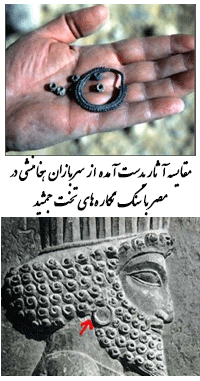
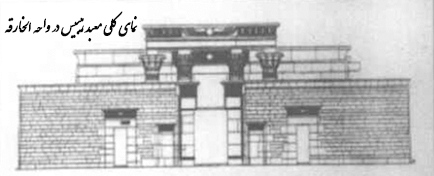
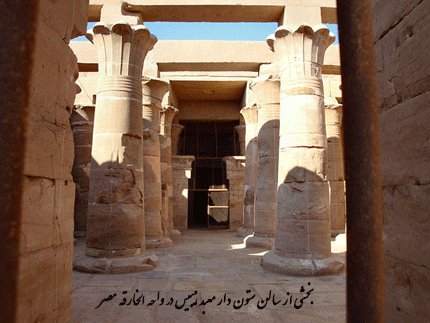
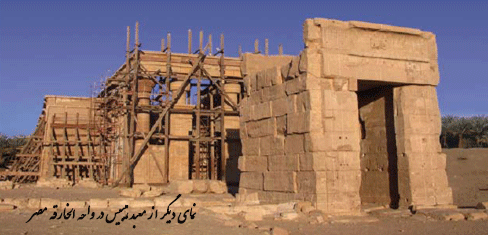

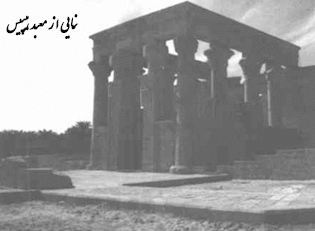
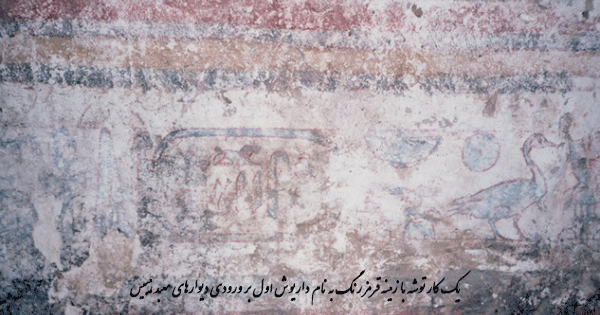
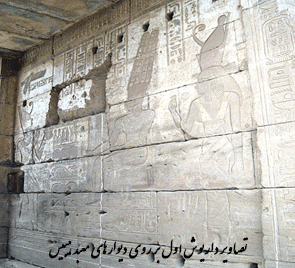
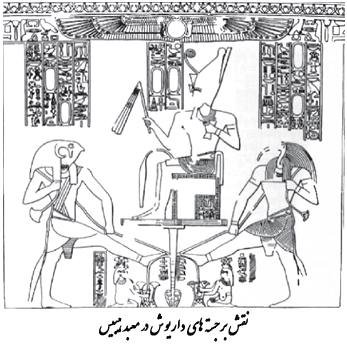
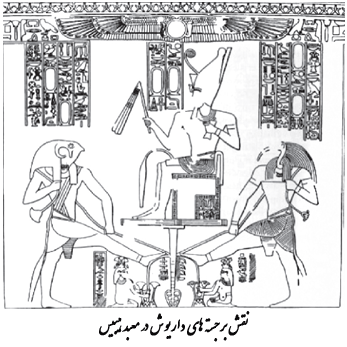
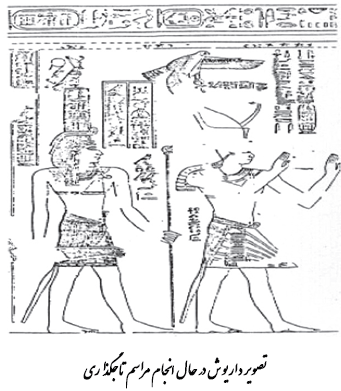
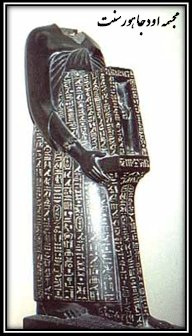
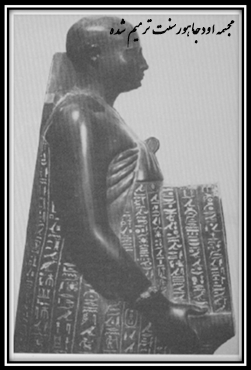
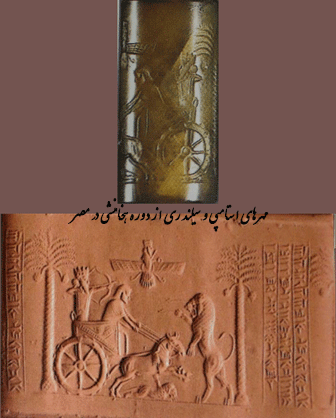
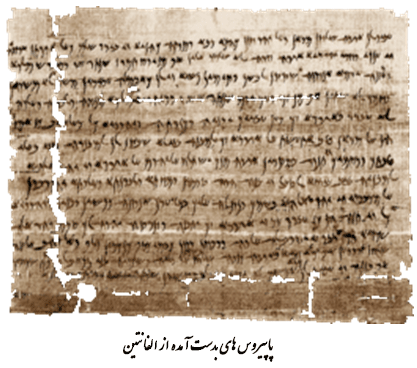
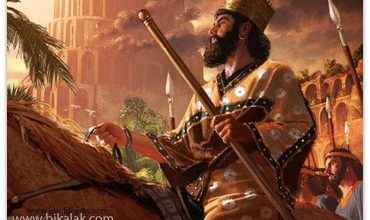
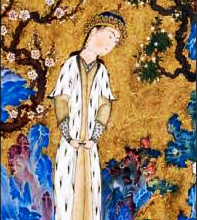
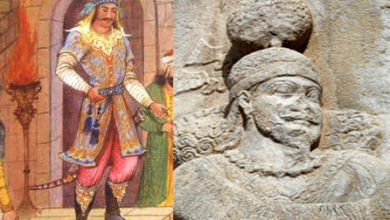
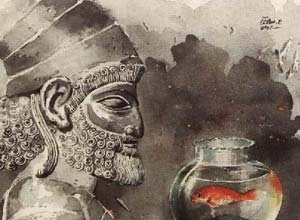
Hello and thank you for your good site. A question has been bothering me for some time and it is about the similarity of Iranian and Egyptian symbols. Is it true that many symbols belonging to the Achaemenid period were created in imitation of Egyptian symbols, for example? An example of the symbol of Forohar or lotus flower
Yes . These symbols have spread among nations and have their own meaning in each nation.
For example, we follow the symbol of Forohar among the nations:((1 The oldest example of this type is in the hand of the goddess Nin Girsu in Sumer. 2 In Egypt, this figure first appears in the form of the god Aton, Khapri, Ra and the eye of Horus. Oto appears. 4 In Egypt, the most obvious example of this image is the god Horus. 5 In the form of the Shamash god in Babylon. The link between the king and the supreme god is in Achaemenid art. ))(The source of the text: Pages 131 to 133 of the documentary guidebook of Persepolis by Abolhassan Najafzadeh Atabaki, published by Pazine 2012)
Be careful that this symbol is dated in the order of numbers, that is, the oldest symbol is similar to Forohar from the Sumerian civilization, and the newest is from the Achaemenid period.. It seems that due to the war and the relationship between Sumer and Egypt, first the symbol is exchanged between these two powers, then with the collapse of Sumer and the creation of the Assyrian Empire and the rule of Babylon, this symbol reaches Assyria and Babylon, finally with the expansion of the Achaemenid Empire. The symbol enters the Achaemenid period . So that in Pasargad, which was being built by Cyrus before the conquest of Babylon, Egypt and Lydi, this symbol of Forohar is not seen, but during the time of Darius, when Iran captured Egypt, Babylon and Lydi, this symbol of Forohar is seen.. It should be noted that the appearance as well as the meaning of this symbol changes in every civilization and the symbol of Forohar in Achaemenid Iran does not mean the same as Forohar in Egypt or Sumer..
Thanks.